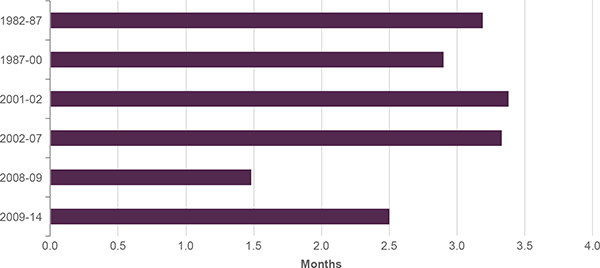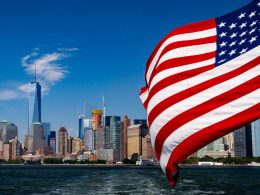August 07 2014
The recent selloff in U.S. stocks is healthy and could set markets up to reach new highs by year end. Long- term investors should not fall victim to panic and sell.
by Scott Minerd, CIO, Guggenheim Partners LLC
An exasperated President Harry Truman once said, “Give me a one-handed economist! All my economists say, ‘on the one hand…on the other.’” Financial markets today probably have a lot of investors wishing for one-handed guidance from a trusted source. I am sensitive to this since I recently predicted a pullback in U.S. equities while also asserting that the bull market could go on for some time. I am known for my strong (sometimes even unpopular) views, so people might think I am talking out of both sides of my mouth when I say U.S. equities could correct further and U.S. equities are fairly priced and could move higher.
As I wrote earlier in the summer, we are nearing the speculative phase of this bull market. At such times, it is very hard to make blanket statements about being bullish or bearish. Decisions are nuanced and depend on whether you are a speculator or an investor. Fundamentally, a speculator invests thinking things will be more expensive tomorrow and an investor buys assets he or she expects will provide exceptional long-run returns.
Do I think U.S. stocks will be higher or lower at the end of the year? The short answer is I think the likelihood is stocks will reach new highs by year end. This little flush over the past week is healthy and should set us up for a nice recovery. Indeed, the chart below suggests the consolidation was overdue. My advice to long-term investors is that this is not the time to fall victim to panic and sell. While market swoons such as last week’s are unsettling, it is worth remembering that while the Dow Jones Industrial Average dropped 22.6 percent on October 19, 1987, stocks ended that year slightly higher than where they were at the start of the year. In the end, “Black Monday” was just a temporary blip in the great bull run of the 1980s.
While volatility is likely to increase in the near term, the fundamentals offer comfort; the equity risk premium now sits at 5.4 percent, above the long-term average of 2.8 percent, suggesting equities are offering a reasonable return for risk. And the S&P 500 Index’s price-earnings multiple of 17.3 times also seems fair given low inflation levels. If you are an investor, avoid the temptation to be short-term focused.
I am reminded of the wise words of my friend Daniel Kahneman, a pioneer in behavioral finance who won the Nobel Prize in Economic Sciences in 2002 for research on decision making. He tells us how frequently we react to market moves is a key factor in how our fortunes fare. “All of us would be better investors if we just made fewer decisions,” says Kahneman. In the case of today’s market, this is good, one-handed advice for investors.
Chart of the Week
Bull Markets Dip Every 61 Trading Days on Average
Hand-wringing over a lasting U.S. equity market correction is rife, but our historical analysis indicates that current market volatility may be just a passing storm. Equity market consolidations of the magnitude we are experiencing are commonplace in bull markets, occurring every 61 trading days on average. The last downturn occurred in April, so the market was due for a drop. However, after a healthy selloff, we expect stocks to reach new highs by year end.
AVERAGE TIME BETWEEN 3% OR GREATER CORRECTIONS*: PAST SIX U.S. BULL MARKETS

Source: Bloomberg, Guggenheim Investments. Data as of 8/6/2014. *Note: Decrease is measured on a rolling 10-day basis.
Economic Data Releases
U.S. Payrolls Are Solid but Miss Estimates
- Non-farm payrolls rose 209,000 in July, missing expectations of 230,000. However, employment has now increased by more than 200,000 for six straight months.
- The unemployment rate ticked up to 6.2 percent in July as the labor force participation rate rose slightly.
- Average hourly earnings were unchanged in July and remained at 2.0 percent higher than a year earlier. Average weekly hours were also flat.
- The second-quarter employment cost index showed a 0.7 percent quarterly gain, the largest since the recovery began and a possible sign of wage pressure.
- The ISM manufacturing index showed strong gains in July, rising to 57.1 from 55.3, the highest level since April 2011. New orders and employment showed particularly large increases.
- The ISM non-manufacturing index jumped to 58.7 in July, better than expected and the highest level since 2005.
- U.S. factory orders had a strong rebound in June, rising 1.1 percent after May’s 0.6 percent decline.
- Personal spending rose 0.4 percent in June, matching gains in personal income.
- University of Michigan consumer confidence was slightly higher at 81.8 in the revised July estimate, but it remains below June’s levels.
- Construction spending suffered the largest one-month drop since 2011 in July, falling 1.8 percent.
- Initial jobless claims fell by 14,000 for the week ended August 1, down to 289,000.
- The trade deficit continued to narrow in June, falling to $41.5 billion from $44.7 billion, mostly due to falling imports.
Euro Zone Sales Rise, China PMIs Diverge
- Euro zone retail sales were up for a third straight month in June, rising 0.4 percent.
- The euro zone CPI ticked down to 0.4 percent year over year in July, the lowest level since 2009.
- Retail sales in Germany rose 1.3 percent in June after falling for the previous three months.
- German industrial production was weaker than expected in June, rising just 0.3 percent after falling for three consecutive months.
- Italy fell back into recession in the second quarter, with GDP down 0.2 percent following a 0.1 percent decrease the previous quarter.
- U.K. manufacturing PMI was weaker than expected in July at 55.4, but that reading was still indicative of a strong expansion.
- U.K. industrial production rose less than expected in June, up 0.3 percent following May’s 0.6 percent drop.
- China’s official manufacturing PMI rose to 51.7 in July, the highest level since April 2012.
- China’s official non-manufacturing PMI declined for a second consecutive month in July, decreasing to 54.2.
- China’s HSBC services PMI fell to 50 in July from 53.1, a five-and-a-half year low.
Copyright © Guggenheim Partners LLC
















